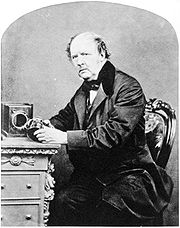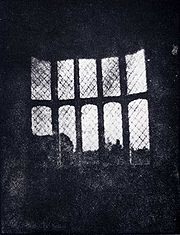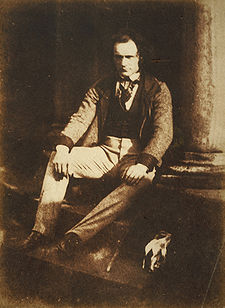
Calotype
Encyclopedia



William Fox Talbot
William Henry Fox Talbot was a British inventor and a pioneer of photography. He was the inventor of calotype process, the precursor to most photographic processes of the 19th and 20th centuries. He was also a noted photographer who made major contributions to the development of photography as an...
, using paper
Paper
Paper is a thin material mainly used for writing upon, printing upon, drawing or for packaging. It is produced by pressing together moist fibers, typically cellulose pulp derived from wood, rags or grasses, and drying them into flexible sheets....
coated with silver iodide
Silver iodide
Silver iodide is a yellow, inorganic, photosensitive iodide of silver used in photography, in medicine as an antiseptic, and in rainmaking for cloud seeding.-Crystal structure:...
. The term calotype comes from the Greek
Greek language
Greek is an independent branch of the Indo-European family of languages. Native to the southern Balkans, it has the longest documented history of any Indo-European language, spanning 34 centuries of written records. Its writing system has been the Greek alphabet for the majority of its history;...
for 'beautiful', and for 'impression'.
How calotypes work
The sensitive element of a calotype is silver iodideSilver iodide
Silver iodide is a yellow, inorganic, photosensitive iodide of silver used in photography, in medicine as an antiseptic, and in rainmaking for cloud seeding.-Crystal structure:...
. With exposure to light, silver iodide decomposes to silver
Silver
Silver is a metallic chemical element with the chemical symbol Ag and atomic number 47. A soft, white, lustrous transition metal, it has the highest electrical conductivity of any element and the highest thermal conductivity of any metal...
leaving iodine
Iodine
Iodine is a chemical element with the symbol I and atomic number 53. The name is pronounced , , or . The name is from the , meaning violet or purple, due to the color of elemental iodine vapor....
as a free element. Excess silver iodide is washed away after oxidizing the pure silver with an application of gallo-nitrate (a solution of silver nitrate, acetic, and gallic
Gallic acid
Gallic acid is a trihydroxybenzoic acid, a type of phenolic acid, a type of organic acid, also known as 3,4,5-trihydroxybenzoic acid, found in gallnuts, sumac, witch hazel, tea leaves, oak bark, and other plants. The chemical formula is C6H23COOH. Gallic acid is found both free and as part of...
acids). As silver oxide is black, the resulting image is visible. Potassium bromide
Potassium bromide
Potassium bromide is a salt, widely used as an anticonvulsant and a sedative in the late 19th and early 20th centuries, with over-the-counter use extending to 1975 in the United States. Its action is due to the bromide ion...
then is used to stabilize the silver oxide.
In the case of salted paper, the sensitive element is silver chloride
Silver chloride
Silver chloride is a chemical compound with the chemical formula AgCl. This white crystalline solid is well known for its low solubility in water . Upon illumination or heating, silver chloride converts to silver , which is signalled by greyish or purplish coloration to some samples...
formed when the salt (sodium chloride) reacts with silver nitrate
Silver nitrate
Silver nitrate is an inorganic compound with chemical formula . This compound is a versatile precursor to many other silver compounds, such as those used in photography. It is far less sensitive to light than the halides...
. Silver chloride decomposes when in contact with light forming silver and chlorine
Chlorine
Chlorine is the chemical element with atomic number 17 and symbol Cl. It is the second lightest halogen, found in the periodic table in group 17. The element forms diatomic molecules under standard conditions, called dichlorine...
evaporates. Excess silver chloride is washed out of the paper and the silver oxidizes in contact with gallo-nitrate. The silver oxide is stabilized on the paper with hyposulphite of soda
Photographic fixer
Photographic fixer is a chemical or a mix of chemicals used in the final step in the photographic processing of film or paper. The fixer stabilises the image, removing the unexposed silver halide remaining on the photographic film or photographic paper, leaving behind the reduced metallic silver...
.
Silver chloride is sometimes favored over silver iodide because it is less sensitive to temperature. During long exposures in direct sunlight the temperature on the paper can be quite high.
The calotype created a negative
Negative (photography)
In photography, a negative may refer to three different things, although they are all related.-A negative:Film for 35 mm cameras comes in long narrow strips of chemical-coated plastic or cellulose acetate. As each image is captured by the camera onto the film strip, the film strip advances so that...
image on the silver iodide from which positives
Positive-negative film
Positive-negative film is instant photographic film that generates both a positive print and a negative from a single exposure on a single medium.Polaroid Type 55, Polaroid Type 665, and Polaroid Type 105 are notable films of this variety....
could be printed (onto silver chloride paper). This made the calotype superior in one aspect to the daguerreotype
Daguerreotype
The daguerreotype was the first commercially successful photographic process. The image is a direct positive made in the camera on a silvered copper plate....
which only made one positive image (whereby it was difficult to get multiple copies).
Use and popularity
Daguerreotypes were much more popular than Calotypes. When Calotypes were introduced Jan. 31, 1839, Talbot patented the idea in every country. Because of this, everyone who used Calotypes had to pay royalties. On the other hand, daguerreotypes were patented only in England, so in America and other places, it could be used freely. Few calotypes were made in the USA.Another main reason for calotypes being less popular was that paper was used for the negative. Because calotypes used opaque paper instead of glass or film for the negative, when prints were made from the negative, the fibers in the paper would cause the positive print to be fuzzy, as compared to daguerreotypes, which were usually sharp and clear

